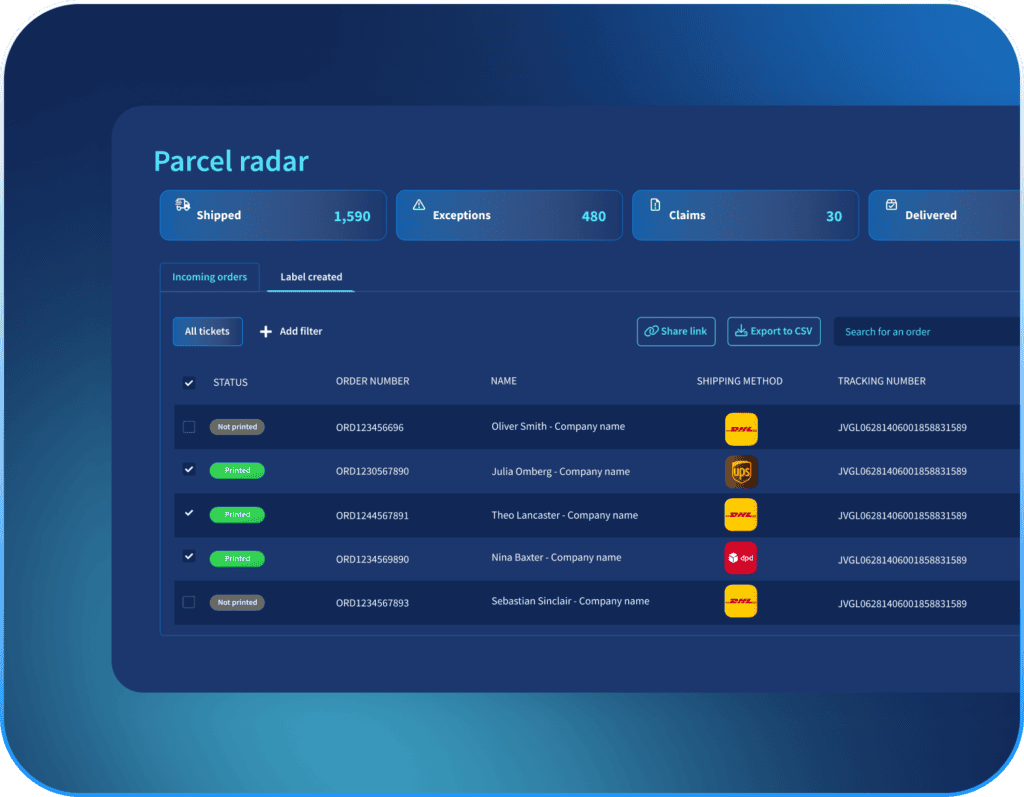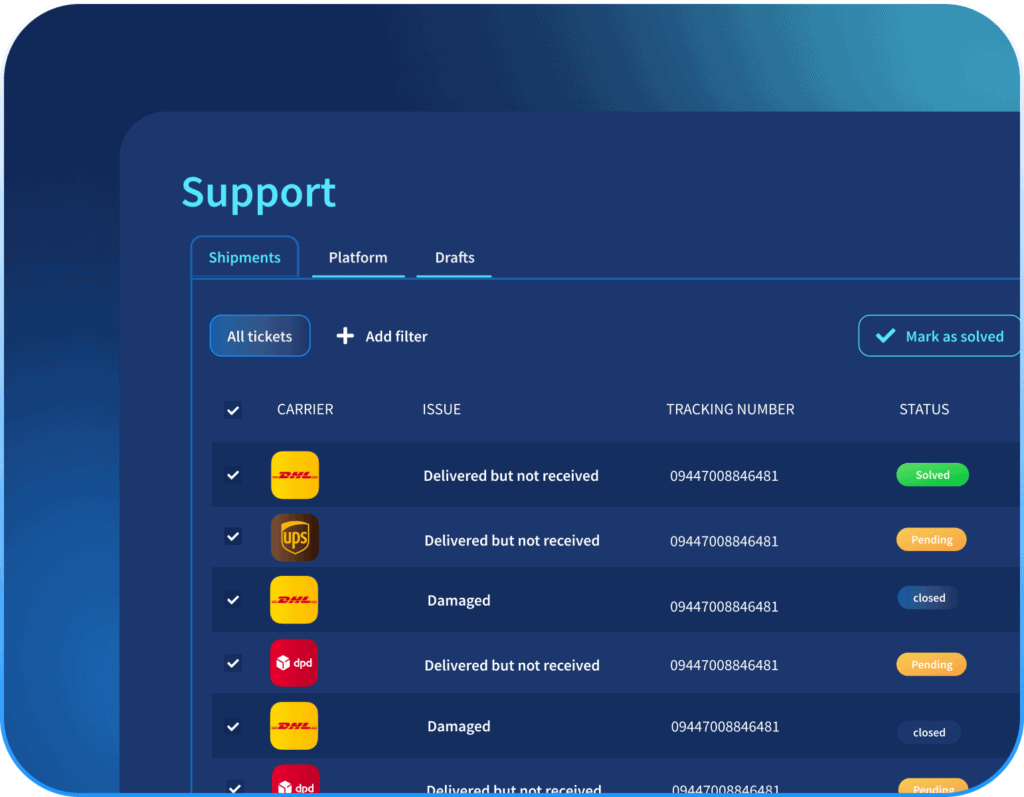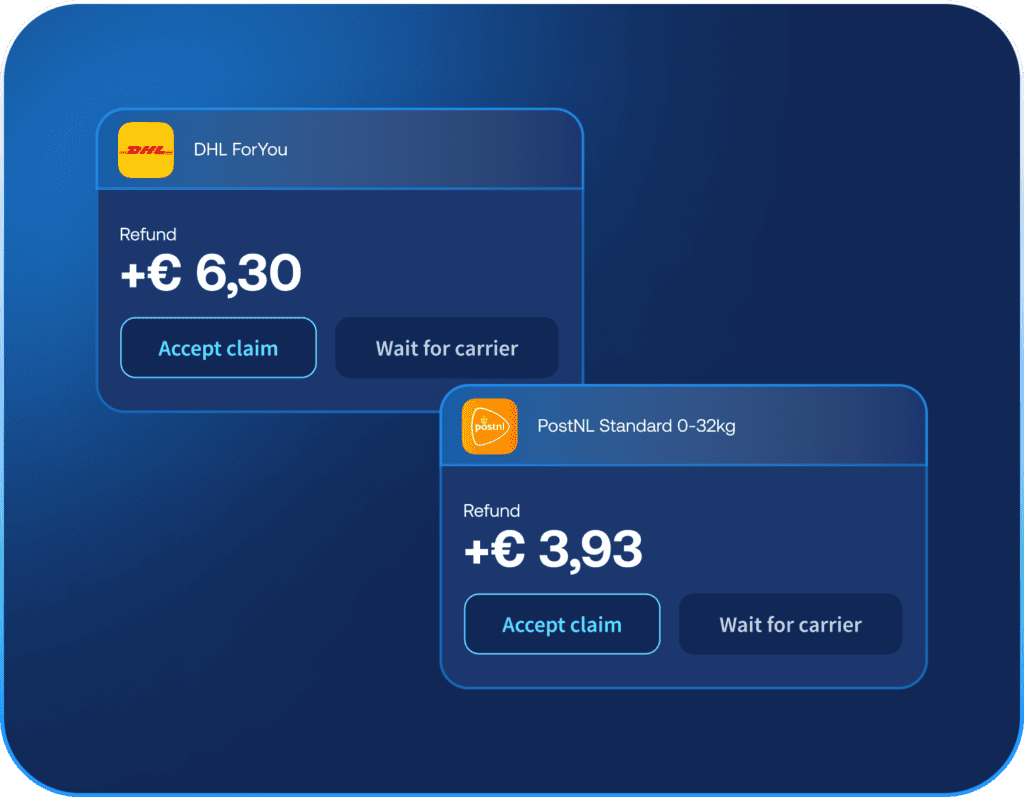Every online order has a journey. It starts with a click. Then a packed box. Then a trip across logistics networks. But sometimes, something goes wrong: a lost parcel, a damaged item, or a late delivery that frustrates a customer enough to send a ticket.
At Sendcloud, we analyzed thousands of e-commerce shipments. What we found? Up to 5.8% of parcels face a potential issue or delay (based on updated internal data). Meanwhile, delivery-related overhead is rising, with 39% of e-commerce retailers reporting double-digit increases in associated costs last year.
And yet, many businesses still “hack” their way through delivery issues — with email chains, spreadsheets, and a heroic amount of manual work.
Customers, meanwhile, expect fast, personal support. And they don’t care what’s happening behind the scenes. They just want answers.
The reality? Most businesses are stuck reacting to problems instead of preventing them. Support automation changes that. It’s the shift from chaotic firefighting to proactive, structured delivery issue management at scale.
What is support automation?
Support automation centralizes carrier interactions and automates the handling of delivery issues — like claims, refunds, and tracking updates — in one clear system.
At Sendcloud, we define it like this:
Support Automation aims to gain visibility into carrier problems and resolve delivery issues faster. It lets you manage all carrier interactions in one place, automate claims, and shift to proactive support.

- Spot shipment issues early
- File and track claims with multiple carriers without manual chasing
- Push delivery issue updates directly into your CRM or helpdesk tools, so your support agents have all the information they need to respond quickly — without switching tabs.
- Recover refunds faster and with fewer errors
Most importantly, it turns scattered manual tasks into a smooth, trackable flow; especially as your shipment volume grows.
How support automation is different from traditional ticketing tools
Traditional ticketing systems were built to handle customer inquiries: “Where is my order?”, “I want to change my delivery address”, “I need a return label”.
Support automation, on the other hand, zooms in on post-shipping problems — the messy middle where shipments get delayed, damaged, or lost. It bridges the gap between customer service teams and the carriers handling their deliveries by automating everything that happens after an issue is detected.
Why manual support processes don’t scale
Smaller teams often start with manual fixes…and that can work for a while. But as order volumes grow, those workarounds quickly become chaotic. Here’s what that looks like in reality:
- Claims buried in spreadsheets and emails
- No easy way to track issues across carriers
- Refunds missed due to lack of visibility
- Overloaded support agents fighting fires daily
Small businesses struggle with no overview. Growing businesses struggle with integrating existing CRMs and scaling processes.
Either way, the outcome is the same: lost time, lost money, and lost customers. Support automation fixes that: by centralizing workflows, automating tasks, and giving you full visibility into operations.
The cost of manual chaos
Manual workflows don’t just cost time. They cost you real money. Every missed refund. Every delayed claim. Every frustrated customer who never comes back.
They also create massive operational risk:
- No visibility = no control over your shipping performance
- No standard process = high error rates
- No tracking = missed opportunities to pressure carriers or negotiate better deals
At Sendcloud, we saw this firsthand when talking to merchants. Even some of the most advanced brands still keep complex spreadsheets just to stay on top of claims.
It was impressive. But it wasn’t scalable. That’s why support automation matters. It replaces manual chaos with structured, scalable workflows that grow with your business.
Key benefits of automating delivery issue resolution
When you’re stuck managing delivery issues manually, every claim feels like a small project. One email here. One spreadsheet update there. One forgotten follow-up buried under 20 other tasks.
Support automation flips that dynamic. Instead of chasing problems, your team gets a clear, simple system to spot, manage, and solve delivery issues, without the endless back-and-forth.
Here’s what changes when you automate:
| Benefit | What changes | Why it matters |
|---|---|---|
| Centralization | One overview for all carrier issues | Faster responses, no lost claims |
| Automation | Claims and reminders handled automatically | Save time, reduce errors |
| Visibility | Real-time tracking and reporting | Smarter shipping and carrier decisions |
| Proactive management | Early issue detection | Fewer WISMO tickets, happier customers |
What processes can be automated in e-commerce support?
Support automation isn’t magic. It’s smart. Instead of replacing your team, it removes the manual steps that waste their time and energy:
- Filing claims: Automatically handle claims when delivery problems are detected.
- Carrier follow-ups: Automatically send reminders if carriers delay responses.
- Status updates: Push claim status to your CRM or helpdesk system.
- Recurring issues: Detect misshipment patterns early and act proactively.
Automation removes manual friction. So you and your team can focus on customers, not paperwork.
When is the right time to adopt support automation?
When you’re sending a few parcels a week, manual tracking and carrier follow-ups feel manageable. You know every shipment by heart. You can handle a lost package with a quick email or a few clicks.
But once you grow, that cozy setup breaks down fast. You know it’s time to automate when:
For small merchants: The overview tipping point
You’re still relatively small, but:
- You rely on personal inboxes to manage delivery issues
- Carrier refunds sometimes get missed because claims fall through the cracks
- Support agents or even the founder spend hours digging through emails
- Customer complaints about delays are rising
If this sounds familiar, you’re at the overview tipping point. You don’t just need to handle issues. You need a system that gives you control and visibility.
For growing merchants: The scaling bottleneck
You’re shipping more. Maybe you hit the 100,000+ parcels per year milestone. You’re managing two or more carriers. You have a small customer service team that’s spending hours each week on carrier claims.
And you’re starting to feel the friction:
- Wasted time filing and following up on claims manually
- Confusion over which claims are still open
- Missed refunds costing real big money
- Agents burning out from repetitive, low-impact tasks
At this stage, manual workarounds aren’t just inefficient. They actively limit your growth by draining resources and slowing down operations.
Support automation lets you move faster, recover costs reliably, and protect you and your team from burnout.
Support automation in action: What it looks like
You’ve seen the problems. You’ve felt the pain. Now, here’s how support automation actually works in practice. Support automation is built around three powerful components. Each layer adds more structure, more speed, and more scalability to your support workflows:
Monitor: Detect problems early

- Spot delivery delays, exceptions, and potential issues early
- Track all shipments in one clear overview
- Alert your team — or your customers — before they even have to ask
Sendcloud’s Monitor shifts your team from reactive firefighting to proactive problem-solving.
Delivery issue management: Track and resolve

Detecting a problem is just the start. Managing it efficiently is where the real impact happens:
- File claims directly with multiple carriers
- Track claim statuses in real-time
- See refund outcomes without digging through emails or carrier portals
No more inbox overflow. No more missing refund deadlines because a ticket got buried.
Delivery issue automation: Handle repetitive tasks

- Automatically handle claims when an issue is detected
- Sending reminders if a carrier hasn’t responded
- Updating your CRM or ticketing tool with the latest claim status
And if you’re ready to go even further? Sendcloud’s Support API makes it easy to integrate support automation into your broader tech stack — no messy hacks required.
Real results: What businesses gain
Adopting support automation isn’t just about making life easier for your support team. It’s about creating real, measurable wins for your entire business.
Here’s what merchants are already seeing with Sendcloud’s Support Automation:
- 8x faster claim resolution: Save time, speed up refunds. Faster claims mean faster resolutions. Faster resolutions mean happier customers. And happier customers mean repeat business.
- 3x faster first response time: Thanks to automatic claim tracking and CRM updates. That’s the kind of speed customers notice — and remember.
- More refunds recovered: More recovered refunds = direct savings on your total shipping costs.
- Reduced pressure on support teams: Delivery issues are one of the biggest time sinks for support teams. By automating repetitive tasks and centralizing workflows, you free up your agents’ time and they feel more in control.
It’s not just operationally smarter. It’s healthier for your team — and better for your brand.
Getting started with support automation in your e-commerce business
Growing an e-commerce brand is tough enough. You shouldn’t have to fight your own support processes just to keep up.
Support automation gives you the tools to scale smarter — without sacrificing the customer experience that made you successful in the first place.
It’s not about giving up control. It’s about gaining visibility, automating the repetitive, and empowering your team to focus on what really matters: helping your customers, building loyalty, and keeping your operations running smoothly.
Whether you’re shipping 500 parcels a month or 500,000, the right systems make all the difference.
Curious how it could work for your business? Explore Support Automation here.















